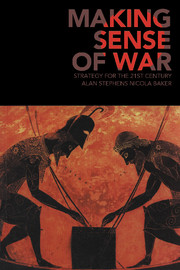Book contents
- Frontmatter
- Contents
- Abbreviations
- Preface
- Introduction
- Chapter 1 How to win
- Chapter 2 Stove-piped strategy
- Chapter 3 Traditional warfighting concepts and practices
- Chapter 4 Manoeuvre and the application of force
- Chapter 5 Shaping the strategic environment
- Chapter 6 Strategic paralysis
- Chapter 7 Contemplating war
- Chapter 8 Constraints on war
- Chapter 9 Controlling war
- Chapter 10 Peacemaking
- Chapter 11 War in the twenty-first century
- Notes
- Select bibliography
- Index
Chapter 4 - Manoeuvre and the application of force
Applying strategy
Published online by Cambridge University Press: 05 June 2012
- Frontmatter
- Contents
- Abbreviations
- Preface
- Introduction
- Chapter 1 How to win
- Chapter 2 Stove-piped strategy
- Chapter 3 Traditional warfighting concepts and practices
- Chapter 4 Manoeuvre and the application of force
- Chapter 5 Shaping the strategic environment
- Chapter 6 Strategic paralysis
- Chapter 7 Contemplating war
- Chapter 8 Constraints on war
- Chapter 9 Controlling war
- Chapter 10 Peacemaking
- Chapter 11 War in the twenty-first century
- Notes
- Select bibliography
- Index
Summary
‘GIT THAR FUSTEST WITH the mostest’ replied the idiosyncratic Confederate cavalry commander, Nathan Bedford Forrest, when asked to explain his strategy for victory in the American Civil War. General Forrest may have been eccentric but he was an intuitive military genius for his times, and as usual he had got straight to the heart of the matter. In essence, he was talking about manoeuvre and the application of force. Once fighting either is about to start or has started, every decision a military commander takes should be informed by the superseding importance of manoeuvre and firepower. Like all good strategic thinking, the maxims of ‘manoeuvre’ and ‘firepower’ are elegantly simple, even though in practice the application of both can be extraordinarily complex.
A useful benchmark against which to test the authority of any alleged strategic maxim is to examine the extent to which it has or has not been affected by technological progress. In this case, regardless of whether the force to be applied will come from a lone infantryman, or from massed land, sea and air power working in unison, the principle of achieving an advantageous position and, if necessary, of then applying decisive firepower, remains as fundamental today as it did for Alexander, Genghis Khan, Napoleon, Nelson, and anyone else who has ever faced an opponent on the field of combat.
- Type
- Chapter
- Information
- Making Sense of WarStrategy for the 21st Century, pp. 69 - 100Publisher: Cambridge University PressPrint publication year: 2006



